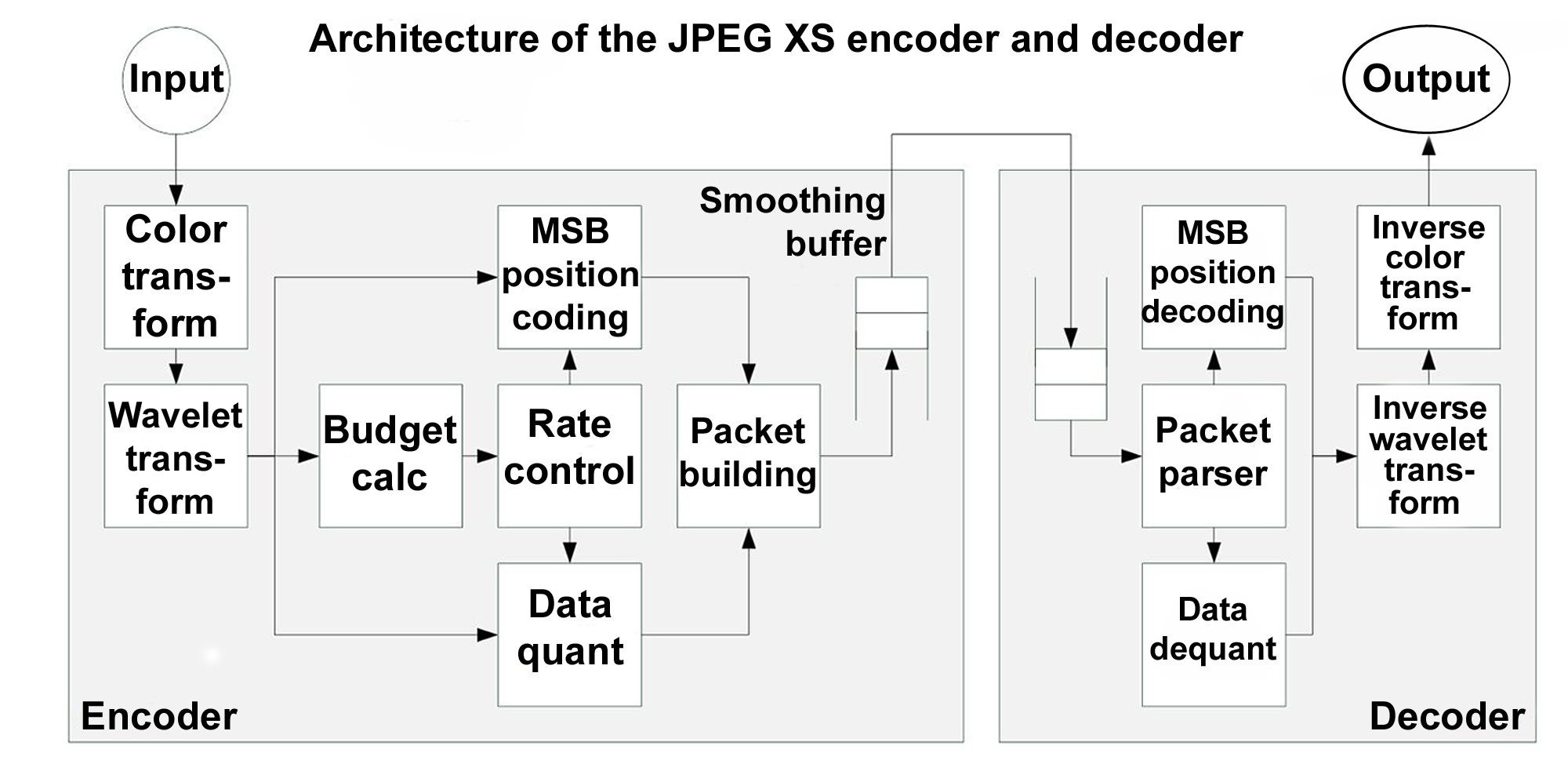JPEG XS Reduces Cabling Bandwidth Needs
ALEXANDRIA, Va.—Every time a new digital production standard gains traction, there is great stress on old infrastructures to carry state-of-the-art (i.e. “broadcast quality”) signals.
In the 1990s, it was SDI for standard definition, which had a data rate of 270 Mbps. That was so much more demanding than the analog signals that came before it, that it required new cables, new connectors, new patch panels, and of course new equipment to handle the digital signals. At the time, 270 Mbps seemed like a breathtaking data rate.
Then in the mid-2000s, broadcasters started upgrading their facilities to HD, with its data rate of 1.5 Gbps. That was for 1080i and 720p HD, and it seemed like a lot of data.
Until the push came for “full” HD with its 1080p frame rate and its demanding 3 Gbps of data. Video facilities that had installed HD-SDI were now upgrading products for a data rate twice as high as HD-SDI.
Although cables and connectors for 3G video are now common, the reality is that the frequency response of copper cables is starting to reach its limit at 3G. When 4K came along and we learned that its uncompressed data rate would be 12 Gbps, there were whispers that it was going to be impossible to send 12G video more than a short distance on coaxial cable.
Despite the whispers, some clever engineers tackled the challenge and there is now a 12G-SDI standard with cable and connectors that can be used to wire real-world facilities. It works and that’s good—although the higher the frequency, the more persnickety the cabling gets. At 12G data rates, a slight crimp in a copper cable or a bend radius that’s a little too tight will cause the signal to deteriorate quickly.
"LOSSLESS" COMPRESSION?
Get the TV Tech Newsletter
The professional video industry's #1 source for news, trends and product and tech information. Sign up below.

There is another way to tackle the problem, however. What if there was a “lossless” compression system that could reduce the necessary bandwidth by four or eight times, without adding complexity or latency?
That standard is being worked on right now, and it’s called JPEG XS.
“JPEG-XS is a newly evolving compression technology that is exciting because it is extremely low latency and also low complexity,” said Andy Rayner, chief technologist for Norway-based Nevion and the director of Nevion’s U.K. technology center. “It is an intra-frame compression—it is spatial only, with no temporal element. It is wavelet-based, and conceptually can be thought of as lots of tiny stripes of JPEG2000. The exciting thing is that where the base compression technology used for JPEG XS-TICO was visually lossless at a compression rate of 4:1, in JPEG XS this is doubled to at least 8:1.”
TICO (which stands for TIny COdec) is a precursor to JPEG XS that promotes a lossless 4:1 compression to permit 12G video to be carried on a single 3G cable. Many manufacturers in the video industry are members of the TICO Alliance, and the same developers are behind JPEG XS.
Rayner knows what he’s talking about. In addition to being awarded the Martlesham Gold Medal for technical innovation, Rayner received a technical Emmy for JPEG 2000 standardization.
When you think compression, you normally expect signal degradation, lots of latency as signals are encoded and decoded, and added power drain as powerful processors calculate how to compress and decompress the signals. JPEG XS specifically targets those concerns.
“I see it as having the potential to replace JPEG2000 as our de facto choice for mezzanine compression,” Rayner said. “The encoder-decode latency is only 32 video lines, which means at only a few hundred microseconds, this becomes negligible compared with other latency in the systems [especially wide area connectivity]. The compression has also been optimized for real estate usage on FPGAs, CPUs and GPUs, which means its use in server technology is also highly viable.”
SAFEGUARDING ADVANTAGES
One of the other goals of the team developing JPEG XS is that it not be specific to any resolution, and be capable of supporting future format requirements, while safeguarding the advantages of an uncompressed stream. These advantages include interoperability, visually lossless quality, multigeneration robustness, low power consumption, low latency in coding and decoding, ease of implementation, small size on chip (no additional DDR memory is required), and fast software running on general-purpose CPUs and GPUs.

“No other codec fulfills this set of strong requirements simultaneously,” said Antonin Descampe, founder of and compression technologist at IntoPIX, a Belgium-based manufacturer of signal compression and processing components. “JPEG XS can thus ‘compete’ with uncompressed in every aspect, and reduce bandwidth and video data significantly.”
There are lots of compression formats out there, including some widely used for their ability to maintain high quality for serious production work. Do we really need a JPEG XS codec?
“The main difference between JPEG XS and existing codecs from JPEG, MPEG or other standardization committees is that compression efficiency is not the main target,” Descampe said. “Whereas other codecs primarily focus on their efficiency, disregarding latency or complexity, JPEG XS addresses the following question: ‘How can we ultimately replace uncompressed video?’”
To many in the television industry, switching from an uncompressed format to a compressed one sounds unwise. The only reason to consider it would be due to the high bandwidth of uncompressed 4K video reaching the limits of what copper cabling can support.
That said, JPEG XS can make a real difference in bandwidth.

“The typical operating points for visually lossless quality with JPEG XS are around 10:1.” Descampe said. “However, it is important to take resolution and content type into account when identifying a maximum compression ratio. For instance, natural content usually reaches higher compression ratios for a given quality level. During its development, JPEG XS has been tested against the strictest quality assessment procedures (ISO/IEC 29170-2, ‘Evaluation procedure for visually lossless coding’), seeking the threshold guaranteeing an ‘indistinguishable flickering’ between original and compressed image—a measure often referred to as ‘visual transparency.’”
DIFFERENT KINDS OF CONTENT
Based on the tests performed by the JPEG XS working group, Table 1 shows the codec’s performance with different kinds of content (screen content, computer-generated images (CGI)) and natural imagery. The lower compressed bitrate in the table defines performance with natural content, while the upper range is for more complex content requiring full visual transparency.

For broadcasters, overall image quality is a big concern, but not the only one. Perhaps equally important is latency, and JPEG XS should address that concern as well.
“In terms of latency, using MPEG-4/H.264 and HEVC/H.265 in a live production workflow with multiple encoding and decoding steps would lead to a compiled latency of many seconds,” Descampe said. “JPEG XS has a microsecond-latency and can thus be run throughout a whole live production workflow without inducing the latency of a single MPEG-4/H.264 encode/decode step. Even though we need H.265 for the last mile to distribute it to the consumer, we try to avoid any additional latency in the production workflow before distribution.”
Descampe said that we should hear about the finalization of the JPEG XS standard around 2019 IBC in September.
“Concerning the status of the standardization process itself, JPEG XS Part-1 [Core Coding System] is published and available as an international standard already,” he said. “Part-2 and Part-3 [respectively profiles and transport formats] are finalized and being prepared by ISO for immediate publication. Part-4 and Part-5 (respectively conformance testing and reference software) are under ballot and shall be published by the end of this year.”
In addition to that standards work for JPEG XS, there are several ongoing liaisons between standards bodies and industrial organizations such as AIMS, VSF, SMPTE, TICO Alliance and IETF. The IP Showcase at the 2019 NAB Show hosted a presentation about JPEG XS in ST2110-22.
WORKING ON IMPLEMENTATIONS
Descampe said that several broadcast suppliers are already working on implementations in their soon-to-be-announced products. And he pointed out one more feature of the standard that makes it compatible with IP video requirements.
“JPEG XS uses a constant bitrate and is thus highly relevant for reliable video over IP transport, especially with compressed video being added to ST 2110 as ‘part 22,’” Descampe said.
Why name this new format JPEG XS? There is some precedent in the JPEG2000 system, which is also used for high-quality video transmission. Why “XS,” however?
“I think the funniest thing is the name,” Rayner said. “It literally stands for eXtra Small!”
Extra small or not, JPEG XS looms large to the people who have been working on it.
“I genuinely expect this to become the de facto mezzanine compression within the next year,” Rayner said.
Further down the line is the possibility that some production facilities may add 8K video capability. The only way to handle uncompressed 8K video data today is to split it into four 12G feeds, as the bandwidth is far beyond what a copper network can carry on a single cable. JPEG XS might be the lubricant that eases 8K production tools into high-end facilities.
Bob Kovacs is the former Technology Editor for TV Tech and editor of Government Video. He is a long-time video engineer and writer, who now works as a video producer for a government agency. In 2020, Kovacs won several awards as the editor and co-producer of the short film "Rendezvous."

